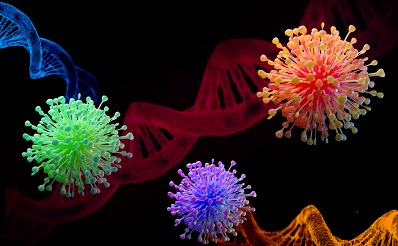BREAKING! A Total Of 23 Different SARS-CoV-2 Strains Found Circulating In The Philippines Including The Potent and Infectious D614G Strain!
Source: SARS-CoV-2 Strains Oct 01, 2020 5 years, 3 months, 1 week, 19 hours, 34 minutes ago
SARS-CoV-2 Strains: Researchers from Philippines and Thailand in a new study have identified a total of 23 different distinct strains circulating in the Philippines including the potent and infectious D614G Strains.

The study results are published on a preprint server but are currently being peer-reviewed for publication into a journal.
https://www.medrxiv.org/content/10.1101/2020.09.29.20203695v1
The Philippines is current witnessing a surge of COVID-19 cases the past two months with to date almost 311,698 cases officially reported and 5,504 deaths. However due to lack of testing facilities in many rural towns and areas coupled with the fact that the proper healthcare facilities and hospitals are out of reach for millions of Filipinos living under extreme poverty, it is speculated that the actual numbers are much higher.
In a new study, a team of researchers at the Department of Virology, U.S. Army Medical Directorate, Armed Forces Research Institute of Medical Sciences in Bangkok, Thailand, the University of the Philippines Manila, and V. Luna Medical Center, Armed Forces of the Philippines Health Service Command reported the coding of complete genome sequences of 23 identified SARS-CoV-2 coronavirus strains circulating at present in the Philippines.
The Philippines reported a surge of COVID-19 cases, spreading across the country since January when the first two cases of the infection were reported.
In mid-March, due to the increasing number of cases, the government imposed an enhanced community quarantine spanning the entire Luzon region. As the months passed by, the National Capital Region (NCR), where Manila is located, has been placed in general community quarantine to allow the reopening of businesses and impose regulations to limit the movement of people in the area.
However as most of the country lifted lockdown orders, increasing cases were reported, prompting the government to implement localized lockdowns in affected areas.
The WHO or World Health Organization reports that as of September 29, of the number of cases reported in the country, 55 percent are male and the most affected group were those between 20 and 29 years old, followed by those who are 30 to 39 years old. These age groups are the working class in the country, making them at a high risk of contracting the virus.
To date, of the total number of cases, 53 percent of cases were reported in the NCR, followed by the CALABARZON region (17 percent), Central Visayas region (7 percent), and Central Luzon (5 percent). Of the more than 5,000 deaths, 61 percent are males, with the most affected age group aged 60 to 68 years old, followed by those who are more than 70 years old. The NCR also reports the highest number of deaths (49 percent).
The study team initially aimed to determine and isolate the different strains of the ravaging SARS-CoV-2 in the country.
The researchers obtained the genome sequences from nasopharyngeal and oropharyngeal swabs from patients who tested positive for COVID-19 between April and July 2020. The patients tested positive for COVID-19 via the reverse transcription-polymerase chain reaction (RT-PCR) test.
<
br />
The study team then used QIAamp viral RNA Mini kit (Qiagen) to extract the viral RNA and used as a template for amplicon sequencing using ARTIC SARS-CoV-2 V3 primers.
Interestingly, the strain details and mutations showed that 20 out of the 23 genomes collected between June and July were classified under clade G.R./lineage B.1.1, a major lineage frequently found in Europe and has spread across the globe.
Another two genomes found between July 6 and 7 were placed under clade G.R./lineage B.1.1.28, which were found in Brazil (89 percent), the United Kingdom (8 percent), and China (2 percent).
Also single genome was found and classified under clade O/lineage B.6, a global lineage mostly seen in Singapore and India.
The researchers said that “Mutation analysis showed the presence of the D614G mutation in the spike protein in 22 of 23 genomes.”
The D614G mutation, the most prevalent variant across the globe, has been tied to higher viral RNA levels and titers and is claimed to be more potent and infectious with numerous new studies supporting these claims.
The virus lineage B.1.1 containing the D614G mutation was observed in samples collected in June. The lineages B.6, B.1.1, and B1.1.28 are the ones present in the Philippines, with the latter as the one first reported in the country.
The study team also noted that all patients in the study had no history of travel outside the country and contracted the virus in the National Capital Region (NCR), Region 3, and Region 4A. All the patients were infected due to community transmission.
It is possible that some of these lineages may have been introduced to the country by travelers or repatriates who came from other countries. Also, as the D614G mutation surpasses the original SARS-CoV-2 strain in terms of prevalence across the globe, which may explain the sudden surge of cases in the Philippines.
Under the current situation, it is highly advisable for most countries especially those in South-East Asia that have yet to be massively impacted by the COVID-19 pandemic to keep their borders closed and to halt all travel in and out of the country till conditions are better. Quarantines and testing are not full proof due to the anomalous characteristics of the SARS-CoV-2 coronavirus. To not do so is simply tantamounting to deliberately putting its local population at high health risk.
For more on
SARS-CoV-2 strains, keep on logging to Thailand Medical News.
